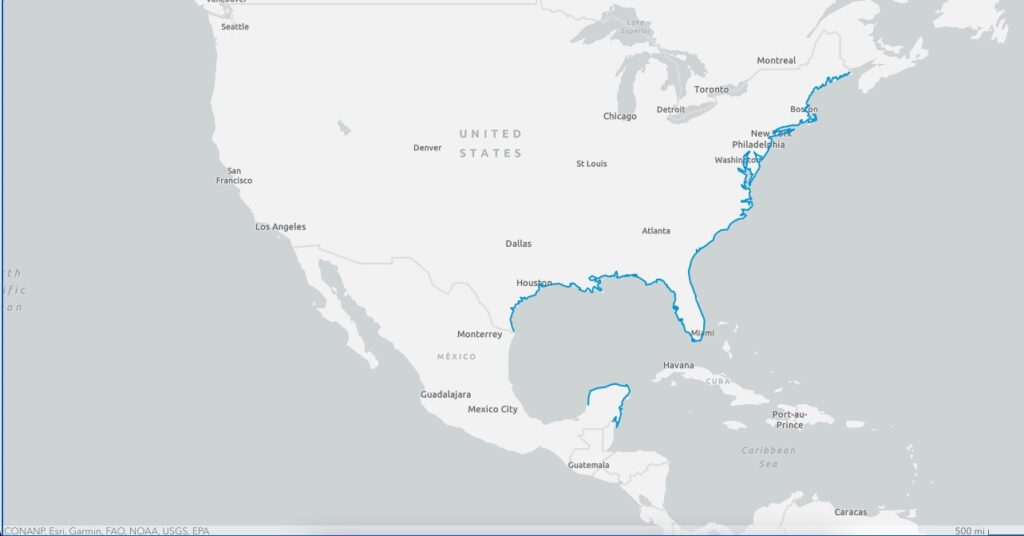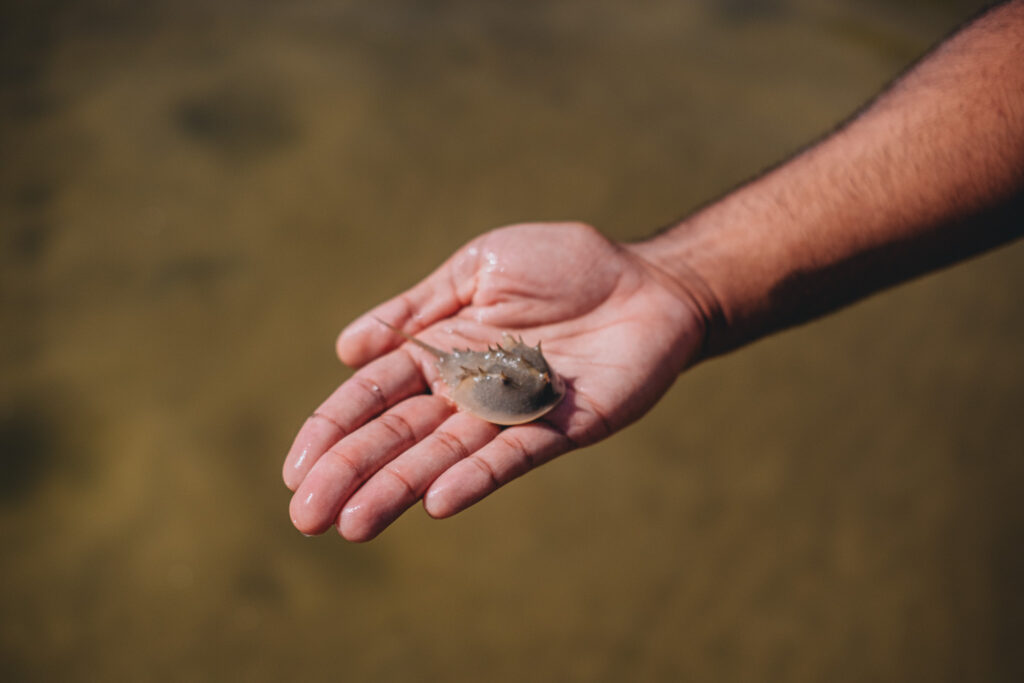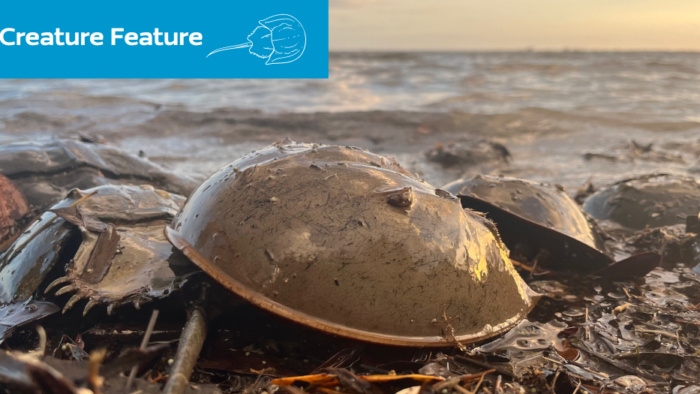American Horseshoe Crab
(Limulus polyphemus)
Range: Maine to Mexico
Habitat: Marine, coast to continental shelf
Physical Characteristics: Horseshoe Crabs are generally olive green or brown, with a brown underside. Males are typically one-third smaller than females.
Spawning Season: Late Spring/Early Summer
Lifespan: 20 years
Fun Fact: Horseshoe crab blood plays a vital role in human medicine.
Conservation Status: Vulnerable, IUCN Red List
Horseshoe crabs have been around for more than 400 million years, making them a living fossil. But despite their name, horseshoe crabs are more closely related to ticks, scorpions, and spiders than crabs.
There are four species of horseshoe crabs – Carcinoscorpius rotundicauda, Tachypleus gigas, Tachypleus tridentatus, Limulus polyphemus. However, the latter species, known commonly as the American Horseshoe Crab, is the only horseshoe crab found outside of Asia.
The American Horseshoe Crab, also known as the Atlantic Horseshoe Crab, lives throughout the Atlantic Coast of the United States, spanning from Maine to Florida. It can also be found in the Gulf of Mexico and the Yucatan Peninsula. The specific marine habitat requirements for the Horseshoe Crab changes throughout their lifecycle; from coastal embayments for eggs and larvae with some adults traveling to the edge of the continental shelf and others living everywhere in between.

Physical Characteristics
The horseshoe crab gets its name from the u-shaped curve of its body. The body is made up of three sections – the head, the abdomen, and the tail. The head is the main part of the body, containing most of the nervous and biological organs, protected by a large plate.
Horseshoe crabs have nine eyes scattered throughout the body and several more light receptors near the tail. This helps them find mates, determine movement and detect changes in moonlight.
The abdomen looks like a triangle with spines on the sides, which are movable for its protection, and a ridge in the center. On the underside of the abdomen are muscles used for movement and gills for breathing.
The horseshoe crab’s tail is long and pointed. Despite its appearance, their tails are completely harmless! They are not used for stinging, only to flip themselves over if they get pushed on their backs.
Horseshoe crabs are generally olive green or brown in coloration, with a brown underside. Males are typically one-third smaller than females. Mature female horseshoe crabs can reach up to 12 inches in width, 24 inches in length from head to tail, and 11 pounds in weight.
Spawning Season
During the late spring and early summer – coinciding with full moons, new moons, and high tides – adult horseshoe crabs journey in masses from deeper ocean water to coastal beaches for breeding. Females release pheromones to attract male mates. As the females come to shore, a male attaches to her shell with his claws.
Several other males may also attempt to mate with a female during a single egg-laying. While spawning, the female crab will partially bury herself in the sand to lay eggs. This process can be repeated several times per season with tens of thousands of eggs annually.

The most notable spawning season on the Atlantic coast occurs at Delaware Bay, which sees thousands of horseshoe crabs eager to breed. The combination of sand and pebble mix on the beach and lack of harsh waves, makes for desirable spawning conditions.
For more information on our Florida team’s observations of the American Horseshoe Crab spawning season, check out our interactive storymap.
Life Cycle
Although horseshoe crabs lay eggs in high quantities, the survival rate is low. Approximately 6 out of 10,000 eggs will hatch. Horseshoe crabs are a keystone species, meaning they are critical to the function of their ecosystem since they provide an important food source for migratory shorebirds, turtles, and fish.

Those that survive often hatch within two to four weeks. In order to grow, the American horseshoe crab must molt, or shed, its protective exoskeleton. Before doing so, the horseshoe crab will begin building its larger skeleton inside the existing one. Once it becomes large enough, it will split open the outer shell. This process can leave the new exoskeleton soft for several hours which makes the horseshoe crab vulnerable to predation. Horseshoe crabs go through about 17 molts during development, reaching adulthood around 10 years old, which is about half of its lifespan.
Horseshoe crabs live in intertidal areas, moving into deeper waters as they mature, feeding on most things they can find – including clams, worms, and algae. Because it has no mandible or teeth, the horseshoe crab crushes food between its legs before consuming.
Threats
In 2016, the American Horseshoe Crab was listed as Vulnerable to extinction by the IUCN Red List. In 2022, IUCN added that the species is Moderately Depleted, meaning declines in population caused by present threats prevent it from being saved in parts of its range. There are several threats to the livelihood of the American Horseshoe Crab, including habitat loss and overharvesting.
As our Florida team has noted, the horseshoe crab’s habitat is hindered by increased beach development. Additionally, horseshoe crabs are harvested to be used as bait for eel and whelks fisheries. Overharvesting is also seen at the hands of the medical field as Horseshoe crab blood plays a vital role in human medicine. Their blood, which turns blue when exposed to high concentrations of oxygen, contains an enzyme called limulus amebocyt lysate (LAL). LAL detects pathogens and is used to ensure vaccines, medications, and prosthetic devices are safe for humans. To harvest LAL, horseshoe crabs are bled before being released back to the sea. Up to 30 percent do not survive this process.
The IUCN states that the population of Horseshoe Crabs in the Florida Atlantic region warrant a Threatened risk category. Due to the continued declining population, it is unclear whether a risk category greater than Vulnerable is needed. Our A Rocha USA team in Florida is contributing to ongoing research by working with the citizen science program, Florida Horseshoe Crab Watch, to monitor the health and behavior of these creatures.
You can support our Horseshoe crab research and other marine conservation efforts by making a donation to A Rocha USA.
Check out these A Rocha Resources:
Interactive Storymap: Crawling through Spacetime
Video Reflection: Wind Waters: A Reflection on Horseshoe Crabs in the Indian River Lagoon
Biologos Podcast: The Ocean Declares | Horseshoe Crabs, Hospitality & Creatureliness











I’m delighted to see that A Rocha USA is bringing attention and good science to the plight of the American Horseshoe Crab. The eggs of these creatures provide crucial food the the migratory Red Knot and other shorebirds. As crabs are over-harvested, the egg supply has dwindled and the birds are in trouble. Knots have been declared Threatened in the US and elsewhere.
As you correctly point out, the production of LAL from horseshoe crab blood is not sustainable. Fortunately, an proven, safe alternative is available: recombinant Factor C (rFC). The drawback is slow action from the US Pharmacopeia in accepting the widely accepted science.
For a detailed peer-reviewed analysis see: https://www.ncbi.nlm.nih.gov/pmc/articles/PMC6200278/#:~:text=In%202012%2C%20the%20FDA%20issued,the%20European%20health%20ministry%20followed.
Also, check out the work of the Horseshoe Crab Recovery Coalition: https://hscrabrecovery.org and consider joining!